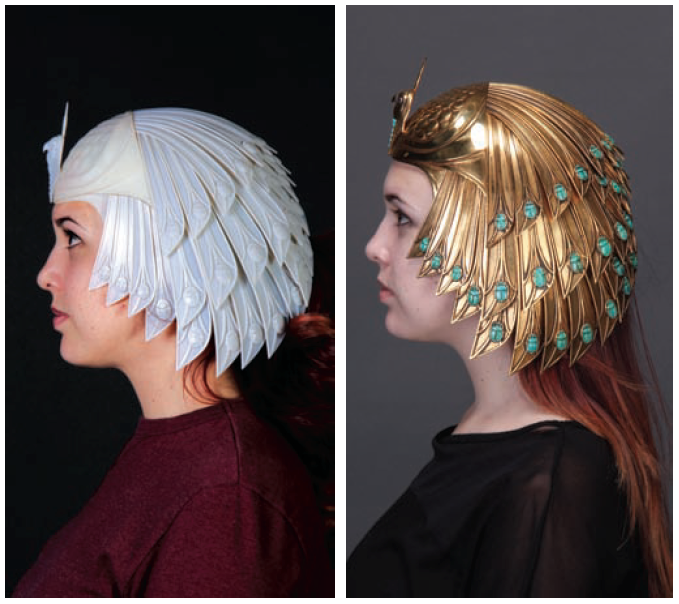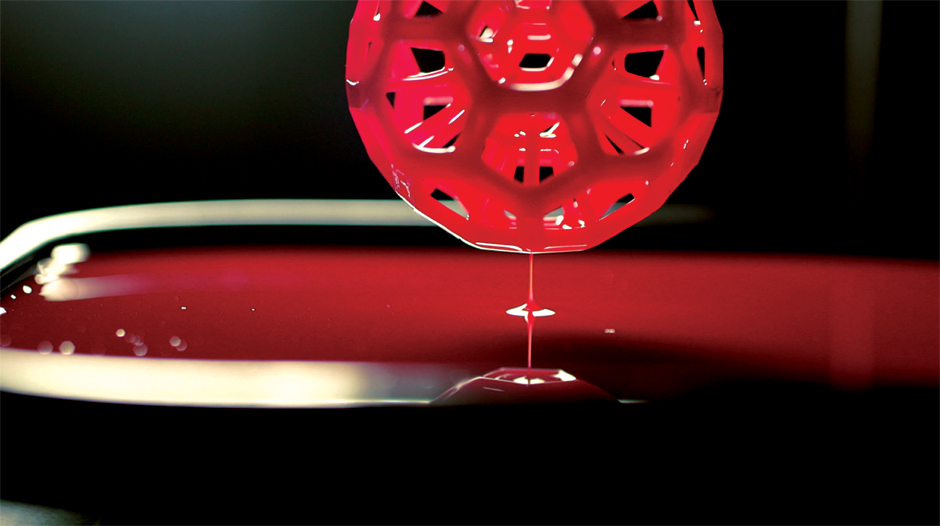Additive Manufacturing Faces Challenges as it Grows
But new technologies may open up options for designers for producing 3-D-printed parts better & faster
Previous Article Next Article
By Robert Grace
Additive Manufacturing Faces Challenges as it Grows
But new technologies may open up options for designers for producing 3-D-printed parts better & faster
Previous Article Next Article
By Robert Grace
Additive Manufacturing Faces Challenges as it Grows
But new technologies may open up options for designers for producing 3-D-printed parts better & faster
Previous Article Next Article
By Robert Grace

In 2014, direct-part production accounted for 42.6%, or about $1.75 billion, of the world’s total AM-related product and service revenues of $4.1 billion that year (data source: Wohlers Associates).

In 2014, direct-part production accounted for 42.6%, or about $1.75 billion, of the world’s total AM-related product and service revenues of $4.1 billion that year (data source: Wohlers Associates).
“The conventional thinking in recent years,” says Caffrey, “is that the sweet spot for production AM is highly complex, highly valuable parts that are produced in very low volumes. That makes perfect sense, and that is [the] case now.”

Tim Caffrey, Wohlers Associates.
“Now, an idea doesn’t get stifled based on the traditional way of bringing it to market. … That’s the real fascinating part for me,” Lopes says. “Any design can move forward, and have potential and possibilities, and that’s going to change things.”

Jason Lopes, Legacy Effects.

Legacy Effects has used 3-D printing and multiple AM systems to create props and special effects for many blockbuster Hollywood movies (photos courtesy of Jason Lopes at Legacy Effects).

Legacy Effects has used 3-D printing and multiple AM systems to create props and special effects for many blockbuster Hollywood movies (photos courtesy of Jason Lopes at Legacy Effects).

How CLIP works (graphic courtesy of Carbon 3D).

How CLIP works (graphic courtesy of Carbon 3D).

A red “buckyball” part rises from a vat of liquid photopolymer during the “CLIP” 3-D printing process. (Photo courtesy of Carbon 3D.)

A red “buckyball” part rises from a vat of liquid photopolymer during the “CLIP” 3-D printing process. (Photo courtesy of Carbon 3D.)
Here is today’s multiple-choice quiz. Pick the right answer below:
Three-dimensional printing/additive manufacturing technology is:
a) a new sensation that is going to revolutionize how we make things;
b) massively hyped with overheated rhetoric;
c) a maturing technology, but one that has a long way to go; or
d) all of the above.
In many ways, curiously, the correct answer is: “d) all the above.” Many of you may realize that 3-D printing has been around for more than a quarter-century, but it’s only in recent years that it has really exploded on to the scene, often garnering the types of headlines usually reserved for cancer cures and moon landings. It is not the next industrial revolution. It will not render obsolete injection molding or other traditional forms of plastics processing.
What it will do, is become an integral part of the product development and manufacturing process; speed the concept of agile, flexible production; drive mass-customization for certain types of highly personalized products; enable the manufacture of extremely complex components; and increasingly become an option for low-volume, mainstream manufacturing, especially of plastic and metal parts.
For many years, 3-D printing has been associated with rapid prototyping, and it remains ideal for that purpose. But as materials and processes have advanced, the technology is being used more for direct manufacturing—skipping the tooling process—and going to straight to commercial part production. (That usage now often is labeled “additive manufacturing” (AM), though many still tend to use AM and 3-D printing interchangeably.)
Direct-Part Production
In its “Wohlers Report 2015,” Colorado-based consultants Wohlers Associates Inc. estimates that direct-part production in 2014 accounted for 42.6%, or about $1.75 billion, of the world’s total AM-related product and service revenues of $4.1 billion that year. That’s up sharply from less than 20% five years prior, and from just 6.6% a decade ago (see graph).
It’s clear that direct-part production is climbing steadily, but additive manufacturing, in its many forms and variations, still faces significant challenges when it comes to broader application. These include high material costs, slow production speeds, a lack of universal quality and certification standards, insufficient operator training, and a general misunderstanding by many manufacturers as to how to effectively design and manufacture for the process.
Perhaps the best-known drivers of 3-D-printed production plastic parts to date are aircraft makers such as Boeing and Airbus. In Boeing’s case, according to Tim Caffrey, senior consultant with Wohlers Associates, the company has been making environmental control system ducting, for both military and commercial airplanes, for many years. He says Boeing has upwards of 100,000 AM-produced parts flying in its planes today. These ducting components are all made of laser-sintered nylon, and are now produced by suppliers to Boeing.
Airbus, meanwhile, recently has become more open about its use of 3-D printing, and says it’s making numerous interior electrical components with SABIC’s Ultem 9085, an amorphous thermoplastic polyetherimide that meets all of the Federal Aviation Administration’s strict fire, smoke, and toxicity standards.
“The conventional thinking in recent years,” says Caffrey, “is that the sweet spot for production AM is highly complex, highly valuable parts that are produced in very low volumes. That makes perfect sense, and that is [the] case now.”
But as AM process speeds increase, Caffrey says he expects some of the inherent benefits of AM—such as the ability to consolidate many parts that need assembly into a single part or to reduce a part’s weight considerably—will lead to AM use in other applications that might be higher volume or might be slightly less-complex and less-valuable single parts.
Another key benefit is that AM enables more agile manufacturing. “You don’t have to tool for something,” he notes. “You can introduce a product in a very low quantity and if it’s a hit, you can tool for it. If it’s a dud, you move on to the next thing. You don’t have to tie up money and capital cost in tooling, and have warehouses full of inventory.” This can lower manufacturing risk, allowing companies to fall back on low quantities and on just-in-time and on-demand business models.
CLIPped Parts
As lead systems engineer at California-based Legacy Effects (formerly Stan Winston Studio), Jason Lopes is a leading practitioner of 3-D printing technology. Leveraging multiple AM systems, along with a host of other tools, he has helped to create props and special effects for many blockbuster Hollywood movies, including Avatar, Thor, Terminator Salvation, and Iron Man, among others.
About 18 months ago, Lopes was handpicked by red-hot Silicon Valley startup Carbon 3D to be a beta user of its much-anticipated CLIP 3-D printing technology. CLIP—which stands for Continuous Liquid Interface Production—claims to be 25 to 100 times faster than existing 3-D printing.
CLIP is a chemical process that balances light and oxygen to eliminate mechanical steps and material layers. It works by projecting light through an oxygen-permeable window into a reservoir of UV-curable resin. By controlling the oxygen flux through the window, CLIP creates a “dead zone”—a thin layer of uncured resin between the window and the object. This makes it possible to “grow” it without stopping. The build platform lifts continuously, rising from a resin bath, as the object is grown.
Citing the commercial quality of the final parts, Carbon 3D—which in 2015 raised $100 million in funding and gained Ford Motor Co. as a partner—says this of CLIP: “Traditionally made 3-D printed parts are notoriously inconsistent. The mechanical properties vary depending on the direction the parts were printed due to the layer-by-layer approach. Parts printed with CLIP are much more like injection-molded parts.”
CLIP offers a much broader range of engineering resins, such as rigid polyurethanes. “These are unlike any materials that I’ve had access to in my other technologies,” Lopes says. Caffrey, who has not yet used a CLIP machine first-hand, urges healthy skepticism and does question whether Carbon 3D’s photopolymers will prove to be UV-stable enough. More time is needed on that.
But Lopes, for one, is a believer. He also uses AM to produce movie-themed collectibles. In the past, he often used a traditional 3-D printing system to make those items. “Now, with [CLIP’s] speed and flavors of materials, we’re just pushing all of that work as much as possible over to that machine.”
He recently did a collectibles project on the CLIP machine that had a finished product size of 2 feet wide by 2 feet tall (60 x 60 cm) and comprised 139 parts. He says such a job previously would have taken him 4 to 6 weeks to print and clean up using a traditional process. Using CLIP, he completed all of it in less than two weeks. “And all we had to do was remove supports. There was no need to go back in and add more detail to the prints. What you see is what you get on that screen.”
Beyond the entertainment industry, Lopes sees huge potential benefits for product development in general. “Once you have a part that you can build directly, and it is suitable for use as an end-use part, I see that as an automated application.”
What this means for Lopes is the potential for more solutions to current problems. “Now, an idea doesn’t get stifled based on the traditional way of bringing it to market. … That’s the real fascinating part for me,” Lopes says. “Any design can move forward, and have potential and possibilities, and that’s going to change things.”
“Multi Jet Fusion”
The industry also is eagerly awaiting the rollout, by the end of 2016, of another potentially disruptive process—Multi Jet Fusion technology from Hewlett Packard (HP).
HP plans initially to build parts using production thermoplastic materials and then eventually, perhaps, with ceramics and metals. With the high number of nozzles per inch for its thermal inkjet arrays, the firm’s proprietary synchronous architecture is capable of printing more than 30 million drops per second across each inch of the working area. HP claims its Multi Jet Fusion technology and its materials are “set to define new levels of part quality, high part functionality, at 10 times the build speed, and at breakthrough economics.”
With HP’s global footprint and deep resources, Caffrey, for one, believes this technology “could be very significant.”
There are new examples almost daily of additive manufacturing technologies being applied to creative end-use applications—from medical prosthetics, to custom sports shoes (Nike, Adidas, New Balance), to automotive engine parts (like the “Polimotor 2,” using Solvay materials). Many challenges certainly remain, but 3-D printing technology, in one form or another, is here to stay, and it will indeed help to reshape the manufacturing landscape.
